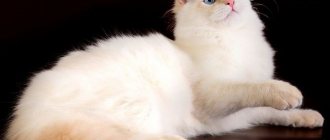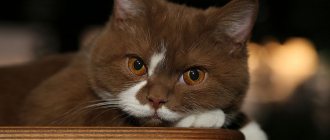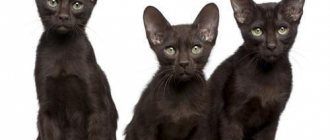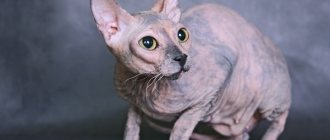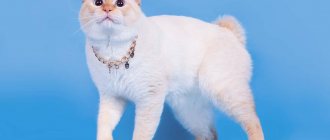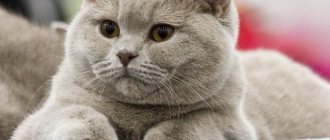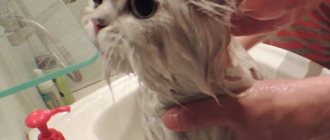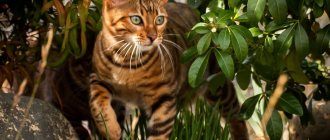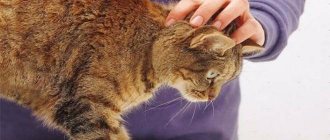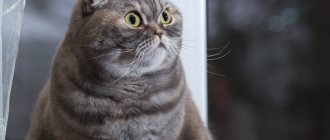Sincere love for pets often forces you to put up with scraps of fur that settle on clothes and furniture during molting. But there are cat breeds that do not shed and are very easy to keep at home.
Read the article to the end, there you will find useful information about animal shedding and allergies (not only to wool).
Sphinxes
Watch a video about cat breeds that do not shed on our Youtube channel Mr. Cat:
List of cat breeds that do not shed or smell
Felinologists have long been engaged in breeding work in order to create a breed that has virtually no odor of its own and is not prone to shedding. While the result is not one hundred percent, it is possible to identify some breeds that at least partially meet these requirements.
Hairless cats
Hairless cats include Sphynxes - Canadian, Donskoy, St. Petersburg, as well as selective breeds bred by crossing with them - Bambino, Elf, Dwelf, Ukrainian Levkoy.
Sphinx cat
The advantages of these cats are obvious. They have practically no fur, only individual hairs that completely or partially cover the body and have a length of no more than two millimeters.
But this does not mean that they do not need to be looked after. More often than not, this causes additional difficulties.
Brown sweat appears on hot bare skin, which must be removed daily by wiping your pet with wet wipes. And once a week, a bathing procedure is required.
In addition, it is necessary to carefully monitor the diet of these animals. At the slightest dietary disturbance, sweating increases and acne may appear on the skin.
The lack of fur makes it necessary to purchase special clothing for hairless cats, since they are very heat-loving and easily catch colds. Sphynxes have a weak, specific odor that some people do not notice at all, while others react negatively to it.
By nature, all sphinxes are calm and cheerful pets, deeply attached to their owners.
Cat Bambino
Rex
This group of cats is distinguished by short and wavy hair that lies close to the body, has no undercoat and practically does not shed.
Rexes known today:
- Cornish;
- Devonian;
- Ural;
- Hermann;
- Selkirk;
- Laperm.
Rexes have almost no smell, they have a wonderful character, are active and playful, and love children very much.
These pets are clean and do not need constant washing and combing. But their diet also needs to be carefully monitored. If the diet is not correct, dark discharge may appear on the back and sides.
Siamese-oriental group
It contains breeds that do not have undercoat. All these animals come from the east and warm countries. Historically, their ancestors lived in hot countries and with the change of season there was no need to “change their outfit.”
The fur of these animals is short, shiny, and lies tightly to the body. If you run your cat’s body at least once every day with wet hands, then a natural change of guard hair will occur unnoticed.
This group includes:
- Siamese;
- Abyssinian;
- Orientals;
- Thai cat;
- Mekong Bobtail;
- Skif Tai Don;
- Balinese;
- Burma.
All of these animals, with the exception of the Siamese cat, have a wonderful character. They are cheerful, very active, inquisitive and devoted to their owner.
The Siamese also does not suffer from passivity, but due to anatomical features (defects of the tail and, consequently, the spine itself), it can be irritable and vindictive.
If your pet's fur suddenly begins to shed intensively, this may be the cause of stress, a hormonal storm, or an incipient disease. It is necessary to consult a veterinarian and follow his recommendations.
Russian blue
This wonderful ancient domestic breed of natural origin, although it has a dense undercoat, is distinguished by the fact that it is little subject to shedding, is very beautiful in appearance due to its unusual color and has practically no odor. The pet has a wonderful character, he is unconditionally devoted to his owner, loves children and treats them like a father. It is not for nothing that this breed is among the ten most sought after in the world.
In addition, this cat is very clean; she constantly takes care of her wonderful fur coat.
Cat fur is considered hypoallergenic. The structure of the hair is such that it is little susceptible to destruction, so bacteria do not settle on it. Reduced hair fragility leads to the fact that the Russian Blue sheds imperceptibly throughout the year, with virtually no undercoat loss.
This cat should not be combed, washed or used with chemical grooming products, so as not to damage the unique hair structure.
Read more about the Russian Blue.
Nibelung
This is a rare breed, which is practically never found in Russia; in all its parameters it is very similar to the Russian Blue. The only difference is that her hair is not short, but semi-long.
The structure of the hair under a microscope allows you to see that it is no different from blue. Therefore, there is no seasonal shedding and the cat is hypoallergenic.
More about the Nibelungs.
Bengal
This amazing breed is the world's first successful hybrid of domestic and wild cats. The ancestor of the Bengal is the Asian leopard cat.
This breed is distinguished by the fact that it requires absolutely no grooming. There is absolutely no need to comb or wash your pet.
A week after birth, kittens begin phasing. This is a process common to all wild cats. It lies in the fact that the baby’s bright color is hidden behind a thick undercoat, which suddenly grows and becomes longer than the guard hair.
In nature, the kitten becomes almost invisible and blends in with its environment. In a Bengal, this manifests itself in the fact that the baby loses its brightness and attractiveness.
The pet grows, is separated from its mother, begins to eat solid food, and learns about the world. His muscles fill with strength, and his body becomes swift and light.
And at one point all the undercoat comes out. By 4-9 months, the ugly duckling turns into a glittery, shiny, like a kid glove, handsome. The Bengal never grows any more undercoat in its life, which means there are no seasonal or indoor shedding.
Phasing was “invented” by nature to protect brightly colored babies from predatory enemies. While the baby is weak and cannot stand up for himself, he should be invisible; the mother is responsible for his life and health.
Also read the great article about Bengals.
When a growing cat gains strength, its color appears in all its glory, and it is ready for independent life. Therefore, Bengal is also a hypoallergenic breed that is not subject to shedding and has virtually no odor.
By nature, they are energetic and cheerful animals, sincerely attached to the owner and household members. They do not tolerate loneliness well, so it is better to buy them in pairs from the nursery.
Rex
If a person still wants the pet to be soft to the touch, you can opt for the Rex. These cats are known for having a curly coat, which provides an unusual appearance. An excellent feature of the Rex is that their presence in the house practically does not give off a specific cat smell: the substances secreted by their glands are not so strongly felt compared to other breeds.
Each variety has its own characteristics:
- The Devon Rex
is considered one of the most suitable options for allergy sufferers. If you periodically comb their sparse coat, you can hardly notice how they shed. Kittens sometimes become sticky due to discharge, this is especially noticeable on the sides and abdomen.
- The Cornish Rex
has only one part of the coat - a shortened undercoat, guard hairs are completely absent.
- The Selkirk Rex
can be short-haired or long-haired, but the structure of the coat with thick curls resembles a sheep's fleece. Particularly pronounced curls are located on the neck, chest, stomach and hind legs of cats.
Rexes are a great option for those who love cats, but are very sensitive to their smell and have difficulty with periods when animals shed. This breed looks exotic, in addition, its representatives are very playful and funny.
A little about molting
All cats with fur experience natural hair loss. This process occurs much more intensely in long-haired breeds and in animals with voluminous undercoat.
Since the fluff in the lower layer has a finer structure, changing this hair brings more inconvenience to the owners - weightless pieces of fur fly throughout the house, settling on clothes and furniture, getting into the eyes and getting into the respiratory tract.
It is not so difficult to survive seasonal shedding; it occurs twice a year - at the beginning of spring and autumn, when the undercoat changes.
But domestic cats that do not walk outside often experience the effect of “indoor” shedding. The cat is constantly warm and shedding its undercoat occurs almost constantly.
Also read what to do if your cat is constantly shedding.
Reviews from owners of hypoallergenic cats
Margarita, Moscow
I am sharing my experience that I gained while keeping several hypoallergenic cats. Every allergy sufferer should keep in mind the fact that the name hypoallergenic does not indicate that allergies from certain animals never occur. In reality, we are talking about a minimal likelihood of developing an allergic reaction due to the lower production of potentially dangerous protein by the animal’s body. I found out that there are no completely hypoallergenic breeds in nature.
David, Samara
In some literature there is an assumption that cats are much less likely to provoke allergies than seals. And another hypothesis - light-colored animals are less dangerous than long-haired ones. You can confirm or refute these facts, but you need to check everything for yourself. The above breeds are called hypoallergenic not because they do not cause allergies, but because they produce the Fel D1 protein in minimal quantities. I have allergies and live happily in an apartment with Sphinxes.
Svetlana, Volgograd
When you make your choice, most likely it will be the breed from this review, start studying safety precautions. I give you some valuable advice. You should bathe your pet 2 or 3 times a week. It is better that the cleaning is done by a person who does not have problems with allergies. Wet room hygiene is required weekly. After petting your cat, be sure to wash your hands. Every day it is necessary to wash the cat’s bowls and personal belongings - toys and more. When you take on a certain breed that you are not yet familiar with, you need to get as much information as possible about it.
According to statistics, about 15% of the world's inhabitants are predisposed to an allergy to ordinary cats, and in one way or another they encounter it. Hypoallergenic animals, although they do not completely protect against allergies, still significantly reduce the likelihood of a negative human reaction to fur and epithelium.
Many people love animals, but not everyone can afford to keep them in their apartment due to allergies to wool.
Allergy sufferers who want to have a furry friend are advised to pay attention to hypoallergenic cat breeds: they do not cause allergic reactions even though some of them have thick and long hair.
Siamese cats
The Siamese cat is a recognizable breed with a specific color and blue eyes. They have an athletic and flexible body.
The animal has short shiny fur. There are clearly defined dark spots on the face, paws, tail and ears. Due to their short hair, the shedding process in Siamese cats is almost unnoticeable.
Males grow up to 4-7 kg, females - up to 3-5 kg. Siamese cats are sociable, affectionate and trusting. They love physical contact very much.
Balinese cat
The Balinese cat is an easy to train animal. It is perfect for both families and single people.
These cats are medium in size. They have fairly short and smooth fur. Life expectancy is from 9 to 15 years.
The fluffy tail of this breed will not cause you much trouble during shedding. He only visually looks long-haired. The hair on the tail of the Balinese cat is as short and smooth as the rest of the body.
Burmese cat
There are several types of Burmese cats. This breed has American and European subspecies. The first are more muscular, the second are more elegant and graceful. Their main difference is their color.
Burmese cats do not have a pronounced undercoat. Their coat resembles shiny sable fur. Which also won’t cause much trouble during the molting period of a cat of this breed.
Abyssinian breed
Such a cat can bring a lot of happiness to the house where she lives. Abyssinians are active, playful at any age, incredibly smart and clean. The owner can teach his pet simple commands. The color is bright, orange or purple. The coat is shiny and looks amazingly beautiful.
Owner reviews are positive. Many note the animal’s high intelligence and its ability to achieve its own goals. The Abyssinian is one of the most recognizable and popular cat breeds without undercoat. She won't let you get bored.
Siamese-oriental
Representatives of this breed have short hair without undercoat. Due to the minimal hair cover, they are very popular with families with children.
Oriental cats have short hair and a very light undercoat.
Attention! Externally, Siamese-Oriental cats are very similar to wild cats; they have short, smooth and shiny fur.
We offer an overview of which cats shed the least among representatives of this breed:
- Siamese: Siamese have short hair with a well-developed undercoat, and there are no problems with combing them;
- Balinese: thanks to the medium coat and the absence of fluffy undercoat, the cat does not become covered with tangles;
- Oriental: Oriental cats have short hair and a very light undercoat, so grooming them is not difficult at all. They practically do not shed, and dead hairs can be removed by wiping the skin with a special rubber glove;
- Mekong Bobtail: these representatives are very beautiful and graceful. They resemble a regular Siamese kitten in color, but have longer hair. They practically do not shed if they are combed out in a timely manner;
- Burmese: very elegant, graceful cats have an equally mysterious color towards dark shades. Their fur is very short, so there will be no problems with caring for it. But their character is not the kindest.
https://youtu.be/_9CRBe_DaVc
Bengal cats
The Bengal cat is an interspecific hybrid. It can be medium or large in size. Their fur is short, thick and shiny.
The color is distinct and contrasting. There is a black or brown pattern on the body. Their character combines the temperament of a wild animal and a domestic pet. If a kitten is not tamed in time, it will grow up wild.
